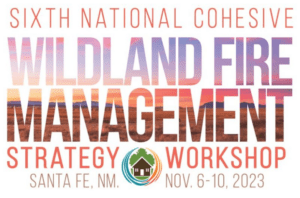Climate & Fire & Adaptation
View report.
In the face of this national challenge, Congress took bipartisan action to establish the Wildland Fire Mitigation and Management Commission through the 2021 Infrastructure Investment and Jobs Act. The legislation charged the 50-member Commission with the ambitious task of creating policy recommendations to address nearly every facet of the wildfire crisis, including mitigation, management, and postfire rehabilitation and recovery. Recognizing the urgency of the crisis, the Commission was given just a single year to conduct a sweeping review of the wildfire system and produce a comprehensive set of policy priorities.
View article.
From 1992–2020, 50% of recreation-caused ignitions in these three states occurred on lands managed by the U.S. Forest Service. The mean annual number of recreation-caused ignitions on national forests in the three states during this period was relatively stable, about 500, whereas recreation-caused ignitions within other jurisdictions decreased by 40%. Improved understanding of the impact of human and climatic factors on recreation-caused ignitions could provide valuable insights for shaping policy and management decisions. We found that mean annual densities of recreation-caused ignitions on national forests were 7 times greater within 1 km of designated campgrounds than >1 km from campgrounds, although 80% of recreation-caused ignitions occured >1 km from designated campgrounds. Ignition density in campgrounds increased non-linearly with overnight visitor density; a doubling of visitor density was associated with a ∼40% increase in ignitions. Large (≥4 ha) recreation-caused wildfires, especially those ignited in designated campgrounds, tended to occur concurrent with drought and 1–2 years after anomalously wet conditions. These results suggest that accounting for drought in implementation of fire restrictions, and targeting wildfire-prevention awareness to recreational users outside designated campgrounds, might reduce the likelihood of recreation-caused ignitions.
View article.
The results project increases in the number of simultaneous 1000+ acre (4+ km2) fires in every part of the Western USA at multiple return periods. These increases are more pronounced at higher levels of simultaneity, especially in the Northern Rockies region, which shows dramatic increases in the recurrence of high return levels.
View article.
Climate change is increasing fire size, fire severity, and driving larger patches of high-severity fire. Many regions are predicted to experience an increase in fire severity where conditions are hotter and drier and changes in fire regimes are evident. Increased temperatures, drought conditions, fuels, and weather are important drivers of fire severity. Recent increases in fire severity are attributed to changes in climatic water deficit (CMD), vapor pressure deficit (VPD), evapotranspiration (ET), and fuels. Fire weather and vegetation species composition also influence fire severity. Future increases in fire severity are likely to impact forest resilience and increase the probability of forest type conversions in many ecosystems.
Webinar recording.
Since 2010, Australian national and state governments have commissioned at least 101 post-emergency inquiries and reviews, each of which makes recommendations to improve the way we prevent, prepare for, respond to and recover from wildfires. Many of these reviews recommend specific changes to laws and policies, for example, to simplify permitting processes for clearing native vegetation and mitigating fire hazards. Of course, catastrophic wildfires are a growing challenge around the world, not just in Australia. Fires are breaking records for size, severity and cost every other year, and ‘unprecedented’ events are becoming distressingly common. As a result, recognition that changing fire regimes will require changes to the rulebooks, is also not limited to Australia. In California, governments have passed laws that have begun to address issues with liability and insurance arrangements for prescribed fire and to promote the reintroduction of cultural fire management. In this presentation, we take a step back and ask: What might it look like to design a great legal framework for the kinds of fire regimes that we are going to see in future? And how might we improve the role of law in facilitating rapid adaptation to increasingly frequent and destructive wildfires, to preserve the hope that we might one day live well with fire?
Webinar recording.
Description: Climate change is not just a global issue, but a local and regional reality. Action is needed at all levels, and the integration of landscape conservation strategies and the natural solutions the landscape conservation community can implement at scale must be considered and supported as part of the climate solution to mitigate and adapt to our changing climactic conditions.
View factsheet.
Across the globe, a network of national parks, nature reserves, and wilderness areas provides necessary refuge for the world’s biodiversity, and yet these spaces are themselves susceptible to the effects of climate change. As the planet warms, species may need to adjust their ranges, moving among protected areas over time to maintain similar climate conditions.
View article.
Here, we outline barriers and opportunities in the next generation of fire science and provide guidance for investment in future research. We synthesize insights needed to better address the long-standing challenges of innovation across disciplines to (i) promote coordinated research efforts; (ii) embrace different ways of knowing and knowledge generation; (iii) promote exploration of fundamental science; (iv) capitalize on the “firehose” of data for societal benefit; and (v) integrate human and natural systems into models across multiple scales. Fire science is thus at a critical transitional moment. We need to shift from observation and modeled representations of varying components of climate, people, vegetation, and fire to more integrative and predictive approaches that support pathways toward mitigating and adapting to our increasingly flammable world, including the utilization of fire for human safety and benefit. Only through overcoming institutional silos and accessing knowledge across diverse communities can we effectively undertake research that improves outcomes in our more fiery future.
View report.
The Nature Conservancy and the Aspen Institute have spent the last year responding to this opportunity by hosting a series of workshops that sought input from all levels of government, Tribal Nations, the private sector, fire-prone communities, philanthropists, academics and other stakeholders, culminating in a Roadmap for Wildfire Resilience. The Roadmap concentrates on the two pillars of the 2014 National Cohesive Wildland Fire Management Strategy—resilient landscapes and fire-adapted communities—that require an investment commensurate with the third pillar—safe and effective wildfire response—to alter the current wildfire trajectory. This Roadmap weaves together lessons from decades of policy and practice with forward-thinking approaches that incorporate new technology and knowledge.
Workshop website.
This Workshop is considered “mission critical” for anyone working on these issues in local, state, Tribal and federal agencies, and organizations as well as non-governmental organizations and private companies. There is no other forum in the nation that provides these opportunities.






